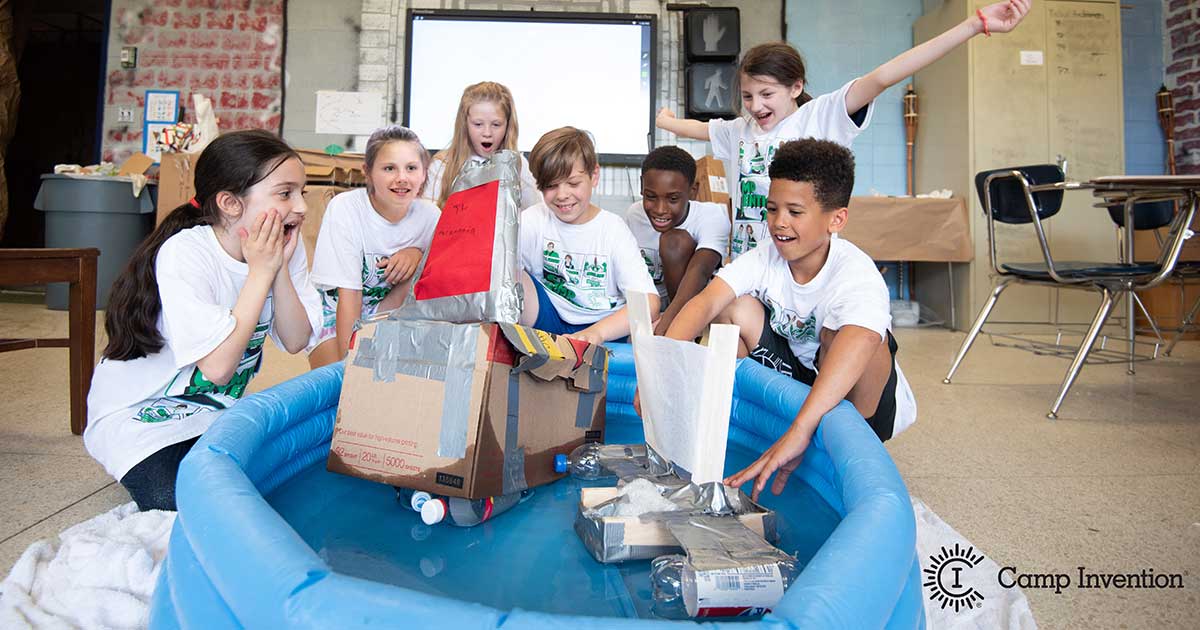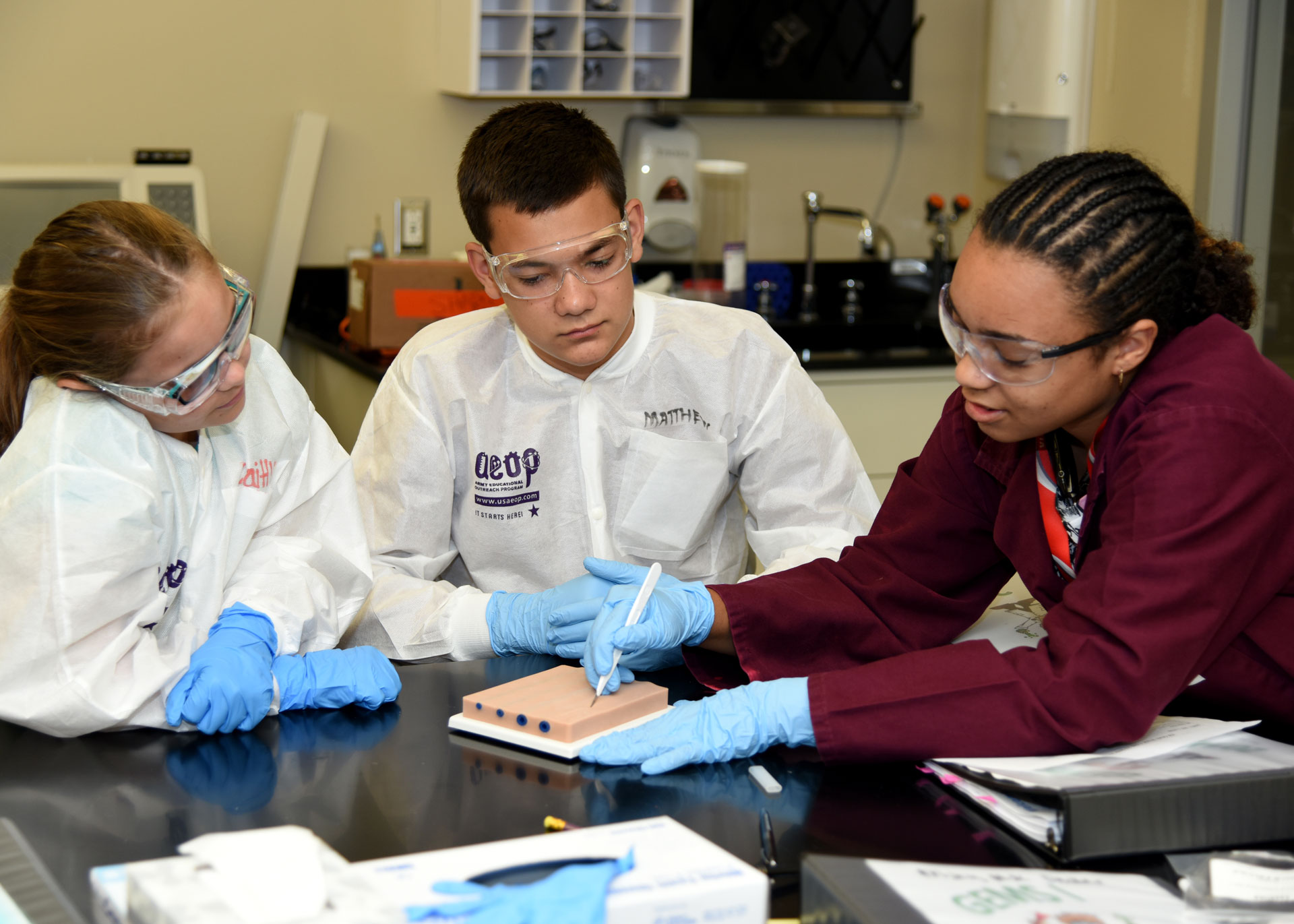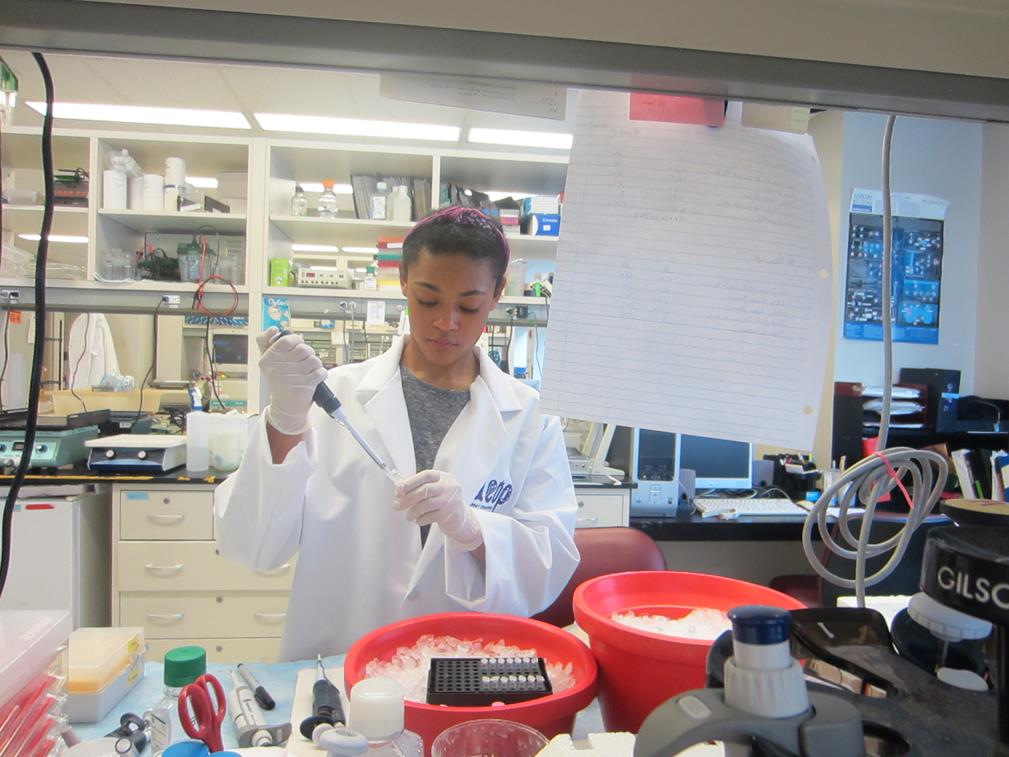
AEOP builds the STEM citizenry of tomorrow, one student at a time
by Jack Meyer
After Noel Obi, 17, graduates from his Houston high school, he plans to go to college to major in mechanical engineering. With an assist from the Army Educational Outreach Program (AEOP), he’s already on the path to that field of study.
By investing in educational programs that target students from kindergarten to post doctorate, the Army is helping develop the science, technology, engineering and mathematics (STEM) leaders of the future. At its onset in 2010, the Army program began by building a consortium of like-minded organizations that are dedicated to creating STEM opportunities for all with the goal of empowering a pool of diverse STEM talent. Through these partnerships, the Army supports STEM enrichment programs and competitions, apprenticeships and scholarships. Using a strong network of Army scientists, committed teachers, school administrators, volunteers and alumni, the programwo-supported activities are promoted in classrooms and at conferences across the country, reaching students in every state and U.S. territory.

THE EXCITEMENT OF INVENTION: Camp Invention students test out one of their STEM inventions during the weeklong summer program, where children seek answers real-world problems. (Photos courtesy of the author)
GROWING PARTNERSHIPS
Obi’s passion for STEM was solidified through his participation in eCYBERMISSION—a national online science, technology, engineering and mathematics competition. Alongside his teammates, he successfully designed a compact bracelet that monitored health information—heart rate, breathing rate—of the wearer. Designed to protect older adults and young children, the bracelet sends an emergency alert to a designated contact if the vitals of the wearer reach emergency levels. The project advanced the team to the competition’s regional and national levels.
The Army Educational Outreach Program is a journey of growth and opportunity for students who are traditionally underrepresented in the STEM fields, and it is the Army’s single centralized STEM education program. The Office of the Deputy Assistant Secretary of the Army for Research and Technology (DASA(R&T)), the Army’s senior proponent for STEM education, works in concert with the U.S. Army Combat Capabilities Development Command (DEVCOM) to provide these unique STEM experiences to students through AEOP. The need for STEM professionals has never been greater, with the number of STEM jobs growing 79 percent, according to the Pew Research Center—and still growing—in the U.S. in the last 30 years. It is AEOP’s mission to help develop the workforce that will meet this need.
The programs these students and educators participate in are hosted in partnership with organizations like the National Science Teaching Association, the National Inventors Hall of Fame, universities and U.S. Army laboratories and centers. The goal of the AEOP is to provide both students and teachers a collaborative, cohesive portfolio of Army-sponsored STEM programs that effectively engage, inspire and attract the next generation of STEM talent in K through college programs and expose them to DOD STEM careers.
Another student, Jada Crockett, 17, from Fort Washington, Maryland, discovered her passion for medicine while learning about the laboratory researchers who focus on finding cures for untreatable diseases. During her Gains in the Education of Mathematics and Science (GEMS)—a summer STEM enrichment program for middle and high school students through participating Army research laboratories and centers—Crockett was exposed to a variety of careers she never knew existed, bolstering her interest in STEM.

MENTORING THE FUTURE: The summer enrichment programs, GEMS, puts middle and high school students at participating Army laboratories, where they can work alongside a Near Peer Mentor on a project.
EDUCATION IN ADVERSITY
This year, the program, along with the rest of the world, faced an unexpected circumstance: COVID-19. In a matter of weeks, the program and its partners had to develop new ways to administer their programs safely and effectively. In the face of so much uncertainty, AEOP maintained its commitment to providing high-quality STEM education to all participants. Through hard work and dedication to their students, nearly all of AEOP was able to offer programming in some capacity. In the cases of Junior Science and Humanities Symposium and eCYBERMISSION, the in-person national competitions were brought to life with video conferences, and students presented their research and projects to a panel of judges virtually. These presentations were live-streamed, so that people from around the world had the opportunity to tune in.
AEOP’s programs cultivate interest in STEM and offer a pathway for STEM civilian talent through enrichment, competition, apprenticeships and experiential education, building an awareness of Army science and technology. Students of all proficiency levels, interests, and social and economic backgrounds are encouraged to participate in real-world STEM experiences while also engaging with Army-sponsored mentors. By practicing alongside a researcher or having the opportunity to interact with STEM professionals, students are able to witness firsthand how the STEM concepts they learn in school become real research and careers.
Much of the strength of AEOP programming can be attributed to the team of teachers and volunteers who support it. Christine Girtain loves to introduce her students at Toms River High School in New Jersey to engaging experiences. That’s why she volunteers with the Junior Science and Humanities Symposium (JSHS), where students compete for scholarships and awards, presenting their original research to a panel of judges and an audience of peers. At JSHS regional symposia, she networks with scientists and other educators to build her knowledge and connect her students to new mentors.
Dr. Bernhard Vogler is an associate professor in chemistry at the University of Alabama in Huntsville and a mentor with the Research and Engineering Apprenticeship Program (REAP), a summer program where college students learn and work alongside Army and university scientists. Before he was a professor and mentor, Vogler began his career as a synthetic chemist, then switched to natural products chemistry and now works in biochemistry and analytical chemistry. Through REAP, he shares his experiences with mentees to model the myriad potential career pathways for this next generation.
Holly Miller teaches integrated STEM to sixth-graders in Indiana while also pursuing a Ph.D. in STEM education at Texas Tech University. Teaching STEM out of a textbook is no longer an option, she says—students need authentic, engaging experiences. Participating in Research Experiences for STEM Educators and Teachers (RESET), which is administered in collaboration with Tennessee Tech, inspired her and provided new resources for her classroom. Hosted by participating Army laboratories and centers, RESET reinforces teachers’ content knowledge through research experiences and interactions with Army and DOD scientists and engineers.
A lot of AEOP programming is geared toward middle school students to increase interest in STEM from a young age, so students enter high school considering a future in STEM. Ymaris Casas is a middle schooler who loves science and has spent several summers building her knowledge through Camp Invention, a weeklong summer camp designed by the National Inventors Hall of Fame that introduces some of the nation’s youngest learners to the world of STEM. Camp Invention’s high-quality curriculum and experiences offer invaluable insights from real inventors inspiring a passion for innovation.
“The Speedsters,” also known to their families as Austin Ledyard and Carter Eibel, competed with Junior Solar Sprint, a solar car building competition hosted by the Technology Student Association. For these middle schoolers, their love of STEM was sparked once they realized they had a shot at winning. By building a better, faster and cheaper solar racer than any other team, they raced their way to the finish line.

EARLY EXPERIENCE: The AEOP Apprentice program allows high school and undergraduate students to conduct real-world research alongside scientists and engineers.
The Technology Student Association also facilitates a summer program for high school students at higher education institutions. The Army Educational Outreach Program not only sparks student interest in STEM at a young age, but keeps students engaged in STEM by creating a pathway of programming for students to follow. That’s where Janay Gilmore experienced hands-on STEM enrichment and career exploration. She reaffirmed that she was on the right track to follow in the footsteps of her hero, Dorothy Vaughan, one of the mathematicians featured in the book and major motion picture “Hidden Figures,” and aims to someday work at NASA. The program focuses on encouraging students like Gilmore to pursue college majors and careers in engineering and other STEM-related fields.
VIRTUALLY EVERYWHERE
To adapt to the new reality, several GEMS and Unite locations took their STEM adventures online this summer, offering students the chance to follow along via virtual instruction. Camp Invention launched Camp Invention Connect, a virtual version of their in-person program. Registered students had activity kits sent to their homes which were full of the materials they needed for the week’s projects. Participants had the option of a screen-free, self-led experience or to connect with certified education coaches and fellow campers to interact and collaborate online.
Since labs were not able to host student researchers, AEOP apprenticeships had to get creative. The Rochester Institute of Technology, the AEOP partner who administers the apprenticeships, created a college credit-bearing course for students who applied for an apprenticeship. Participants will have the chance to take an online course. Though AEOP looked different this year, the commitment to building and diversifying STEM education and careers remained a unifying theme.
| ECYBERMISSION
eCYBERMISSION is a free, web-based STEM competition for students in grades six through nine that promotes self-discovery and enables all students to recognize the real-life applications of STEM. Teams of three or four students are instructed to ask questions (for science) or define problems (for engineering), and then construct explanations (for science) or design solutions (for engineering) based on identified problems in their community. Students compete for state, regional and national awards. The competition is run in partnership with the National Science Teaching Association (NSTA). GEMS Gains in the Education of Mathematics and Science (GEMS) is a summer STEM enrichment program for middle and high school students that takes place at participating Army research laboratories and centers. GEMS’ mission is to inspire young people to pursue STEM careers. It’s important, especially for those who may not have given serious thought to becoming scientists or engineers, that we reach them early enough so they can attain the right academic foundations to successfully continue their STEM studies in college. The Army-sponsored competition is run in partnership with NSTA. JUNIOR SCIENCE AND HUMANITIES SYMPOSIA The Junior Science and Humanities Symposia (JSHS) is a STEM program sponsored by the U.S. Army, Navy and Air Force that promotes original research and experimentation in STEM at the high school level. Students have the opportunity to compete at the regional and national level. JSHS is run in partnership with NSTA. AEOP APPRENTICESHIPS AEOP Apprenticeships provides a unique opportunity for high school and undergraduate students to conduct real-world, Army-sponsored research alongside scientists and engineers in world-class facilities. They inspire students to pursue further education and careers in STEM and demonstrate the importance of research and development. The apprenticeships are run in partnership with The Rochester Institute of Technology. CAMP INVENTION Camp Invention is a weeklong summer adventure with activities that explore connections in science, technology, engineering and innovation. Throughout the week, children rotate through various modules that encourage them to work together, seek solutions to real-world problems and sharpen critical 21st century skills. The program is run in partnership with the National Inventors Hall of Fame (NIHF). Junior Solar Sprint (JSS) is a competition for fifth to eighth-graders to create the fastest, most interesting and best crafted solar-vehicle possible. Students will design, build and race solar-powered cars using engineering skills and principles of science and math. They develop teamwork and problem-solving abilities, investigate environmental issues and gain hands-on STEM skills along the way, too. The competition is run in partnership with the Technology Student Association. UNITE Unite is a pre-collegiate summer experience for high school students held at higher education institutions across the country. Unite encourages students to pursue college majors and careers in engineering and other STEM-related fields through a program of focused hands-on rigorous academics, enrichment and career exploration. The program is run in partnership with the Technology Student Association. RESEARCH EXPERIENCES FOR STEM EDUCATORS AND TEACHERS Research Experiences for STEM Educators and Teachers (RESET) provides an opportunity to get summer research experience at participating Army Laboratories and Centers. This enrichment reinforces teachers’ content knowledge through research experience and interactions with Army and DOD scientists and engineers. Teachers can translate this knowledge and experience into enhanced STEM research curricula for their classrooms, resulting in deeper learning for their students. The program is administered by Tennessee Tech University. |
CONCLUSION
With help from AEOP and its partners, educators and students are gaining access to experiences, resources and social capital that will shape the next generation of STEM innovators and leaders, despite the circumstances limiting access to in-person education, due to the COVID-19 pandemic.
The need for STEM literacy—the ability to understand and apply concepts from science, technology, engineering and mathematics in order to solve our own day-to-day and even our nation’s most complex problems—is growing exponentially. Through AEOP, the Army continues its long tradition of advancing STEM education by preparing the students of today to solve the challenges of tomorrow.
For more information on the AEOP, go to: https://www.usaeop.com/about/.
JACK MEYER is a STEM and Workforce Senior Analyst with Credence Management Solutions supporting the Office of the Deputy Assistant Secretary of the Army (Research & Technology). He supports the Army Educational Outreach Program (AEOP), which provides both students and teachers a collaborative, cohesive, portfolio of Army-sponsored STEM programs that effectively engage, inspire and attract the next generation of STEM talent with kindergarten through college programs and expose them to Department of Defense STEM careers. The AEOP reaches over 28,000 students and teachers each year.
Read the full article in the Winter 2021 issue of Army AL&T magazine.
Subscribe to Army AL&T – the premier source of Army acquisition news and information.
![]()







